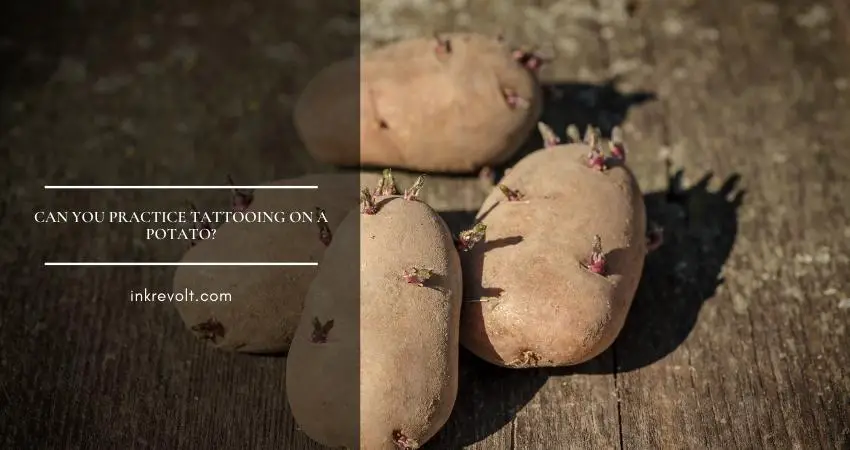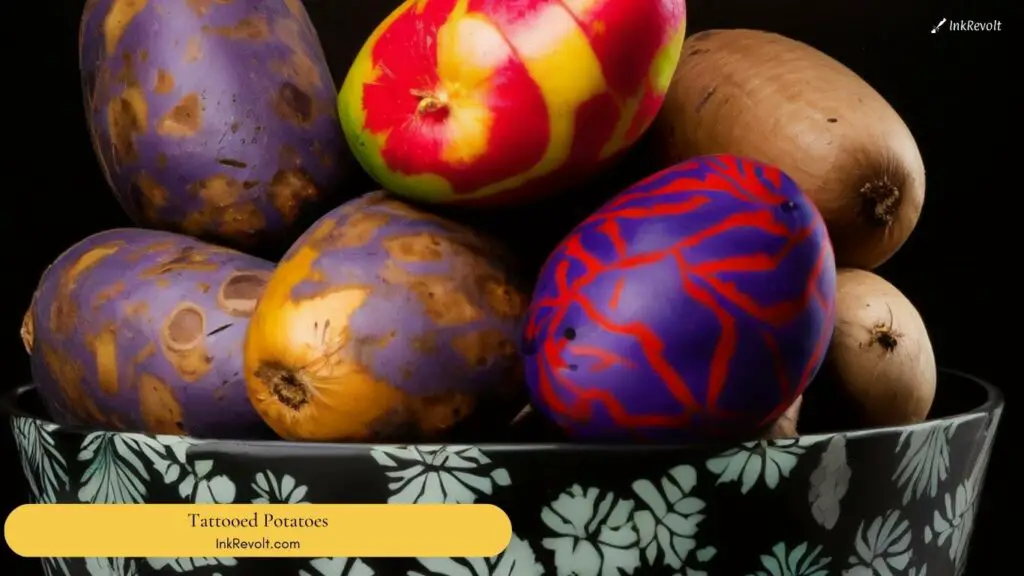Can you Practice Tattooing on a Potato?
As an aspiring tattoo artist, you need to practice a lot. And you want surfaces that have contours and mimic human skin to work on. That brings up the question, can you practice tattooing on a potato?
Practicing on a potato is possible, but it isn’t a recommended option. Fruits, synthetic skin, and pig skin are much closer approximates. That said, people have practiced tattooing on potatoes in the past, and so can you.
You might be considering potatoes for their availability and cost. Unfortunately, potatoes aren’t the best choice in either of these regards. But before you take my opinion for granted, let’s take a look at the history and usability of potatoes as a tattooing surface, and the plethora of alternatives out there.
History of Potatoes as a Tattoo Practice Surface
Until very recently, body art wasn’t seen as an acceptable practice. Tattooing, in particular, was associated with the rough crowd, vandalism, and crime. To this date, many still do not see tattoos as a positive, healthy mode of self-expression and frown upon the practice.
Potatoes played an important role for those early adopters of tattooing. In the book “Bad Boys and Tough Tattoos- A Social History of the Tattoo with Gangs, Sailors, and Street Conner Punks 1950-1965”, Samuel M. Steward writes of using potatoes as practice surfaces for tattooing. He mentions that it was specifically recommended to practice on Idaho potatoes.

But potatoes were not the first choice for their stellar quality as practice surfaces. They were chosen often because of availability, and the fact that they could be rapidly discarded. As practicing tattooing was heavily monitored and socially stigmatized, these were the only qualities that mattered. Otherwise, grapefruit was elected to be the better alternative.
So, potatoes have a history of being tattooed upon, but only because of social stigma. However, aside from the historical evidence, what about the contemporary evidence? Can you practice tattooing on a potato today, and learn more effectively than using any alternatives?
Potatoes in Contemporary Tattooing Practice
Potatoes are still in use as practice surfaces to date. You can find people who practice on potatoes, though the number seems low. The natural contours and thin skin or peel of the potato are considered to be beneficial for practicing tattooing, and there are claims that the peel’s thinness can help you experience the thinness of the epidermis layer.

The most recommended method of practicing tattooing on potatoes was to do so on washed, unpeeled potatoes. Potatoes that have high starch content will be tougher, and you can risk warping or breaking your needle while you practice. Potatoes such as Idaho Russet will be better as they are softer uncooked.
However, potatoes aren’t the first surface that anyone will recommend if you ask about practice surfaces. The most recommended options are either fruit or synthetic and pig skins. I’ll explain why, and how both are superior to practicing on potatoes.
Read More: How Can You Make Fake Skin For Tattooing?
Why Practice Tattooing on Fruits?
The supporting argument for practicing on potatoes today would be the price and its textural similarity to human skin. Idaho Russet potatoes in particular cost around $1.36 per pound, and they are the most recommended variants to practice on. An issue with potatoes is that they bleed ink while you’re working on them, and dealing with that can be a hassle.
However, the common recommendation for practice surfaces are fruits, and potatoes are hardly mentioned. Of all the fruits, there are four that are the most recommended. I’ve provided their cost and quality comparisons to potatoes here.
- Honeydew melons are the most recommended fruit to practice on. Their rinds are said to be the closest approximations to human skin within fruits or vegetables and working on them is a relatively clean experience. These cost $0.83 per pound, which is a little more than potatoes.
- Grapefruits and oranges are considered a close second in quality as practice surfaces, as they both possess porous peels that mimic the texture of the human skin. The only problem with working on them is that they bleed ink if you inject excessive amounts, but they still perform better than potatoes. Unfortunately, both are significantly pricier options than potatoes. Grapefruits cost $1.25 per pound, while Oranges cost $1.45 per pound.
- Bananas win against potatoes on both quality and price. Bananas are considered to be the third-best option, as they possess a smooth, thin peel and natural contours. They don’t bleed ink as easily. Bananas cost $0.62 per pound, cheaper than potatoes.
Potatoes clearly lose out in quality and cost compared to the first and third best options. While honeydew melons may be more expensive on paper, their value is higher than potatoes if you consider the cost-benefit ratio. Now, let’s compare potatoes to synthetic and alternative skins.
What is the best fruit to practice tattooing on [Video]
Potatoes vs. Synthetic and Alternative Skins
The very concept of synthetic or alternative skins is to mimic the human skin as closely as possible. Naturally, you’d assume them to be more expensive than potatoes. On a surface inspection, you’d be right. While potatoes are inferior in quality to these options, let’s take a look at the prices and see what you’re getting.
- Synthetic skins are rubber or silicone-based, and they mimic the layers and conditions of the human skin quite well. But the texture isn’t the same, and you’ll get flat sheets that don’t offer any curves to throw curve-balls at you. You’ll be paying $2 per sheet, which gets exponentially more expensive for practice.
- Pig skin is the closest approximation of all options available for practice surfaces. It mimics the layers, the conditions, and the texture of human skin perfectly. But you need to get them fresh and work on them within the hour, or they lose their integrity. Also, it is the most expensive option, coming at $5 or more per sheet.
Again, this further proves that potatoes are better cost-wise than synthetic or alternate practice skins. But in reality, potatoes lose out the most in both quality and cost if you know how to make your own practice skin.
All you need are the following ingredients.
- 1/4th of a cup or 2 oz of cornstarch or flour.
- 1/3rd of a cup or 2.7 fl oz of warm water.
- 2 fl oz or less of flesh coloring.
- 3 fl oz or less of clear school Elmer’s glue.
Mix these ingredients together well to create a dough and knead it well till it’s firm but malleable. Roll the dough into a thin, flat sheet and then cut it into pieces. Let the sheets dry, and you have your very own synthetic skin.
The quality is quite similar to a rubber-based skin. And you don’t have to worry about premium quality ingredients, so you pick the cheapest flour, cornstarch, and flesh color options.
The quoted amount of ingredients will cost you $0.90 per batch of skin you’ll produce. And you’ll get 4 to 6 times the surface area to work with than per pound of potatoes. The best part is that you can wrap the soft sheets around a conical object or other shapes to mimic human appendages, and once they have hardened, you’ll have the most natural, human-like contours you’d want for practicing.
Parting Words
Potatoes aren’t the best option by quality, nor are they the best by cost. Practicing tattooing on potatoes seems to be a poor choice these days, especially compared to producing your own artificial skin. The issue with bleeding ink will frustrate you, and it won’t be as close an approximation as the other options out there.
But can you practice tattooing on a potato if you had no choice? Are they viable if you have relatives, friends, or neighbors who don’t like tattoos, and you need the unexpected option to practice? If that’s the case, then go for it. Potatoes will serve you just fine.
